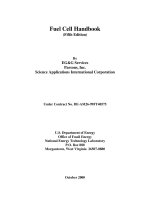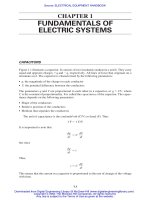ELECTRICAL SAFETY HANDBOOK docx
Bạn đang xem bản rút gọn của tài liệu. Xem và tải ngay bản đầy đủ của tài liệu tại đây (9.65 MB, 621 trang )
ELECTRICAL
SAFETY
HANDBOOK
This page intentionally left blank
ELECTRICAL
SAFETY
HANDBOOK
John Cadick, P.E.
Cadick Corporation, Garland, Texas
Mary Capelli-Schellpfeffer, M.D., M.P.A.
CapSchell, Inc., Chicago, Illinois
Dennis K. Neitzel, C.P.E.
AVO Training Institute, Inc., Dallas, Texas
Third Edition
McGRAW-HILL
New York Chicago San Francisco Lisbon London Madrid
Mexico City Milan New Delhi San Juan Seoul
Singapore Sydney Toronto
Copyright © 2006 by The McGraw-Hill Companies, Inc. All rights reserved. Manufactured in the
United States of America. Except as permitted under the United States Copyright Act of 1976, no part
of this publication may be reproduced or distributed in any form or by any means, or stored in a data-
base or retrieval system, without the prior written permission of the publisher.
0-07-158912-0
The material in this eBook also appears in the print version of this title: 0-07-145772-0.
All trademarks are trademarks of their respective owners. Rather than put a trademark symbol after
every occurrence of a trademarked name, we use names in an editorial fashion only, and to the
benefit of the trademark owner, with no intention of infringement of the trademark. Where such
designations appear in this book, they have been printed with initial caps.
McGraw-Hill eBooks are available at special quantity discounts to use as premiums and sales
promotions, or for use in corporate training programs. For more information, please contact George
Hoare, Special Sales, at or (212) 904-4069.
TERMS OF USE
This is a copyrighted work and The McGraw-Hill Companies, Inc. (“McGraw-Hill”) and its licensors
reserve all rights in and to the work. Use of this work is subject to these terms. Except as permitted
under the Copyright Act of 1976 and the right to store and retrieve one copy of the work, you may not
decompile, disassemble, reverse engineer, reproduce, modify, create derivative works based upon,
transmit, distribute, disseminate, sell, publish or sublicense the work or any part of it without
McGraw-Hill’s prior consent. You may use the work for your own noncommercial and personal use;
any other use of the work is strictly prohibited. Your right to use the work may be terminated if you
fail to comply with these terms.
THE WORK IS PROVIDED “AS IS.” McGRAW-HILL AND ITS LICENSORS MAKE NO GUAR-
ANTEES OR WARRANTIES AS TO THE ACCURACY, ADEQUACY OR COMPLETENESS OF
OR RESULTS TO BE OBTAINED FROM USING THE WORK, INCLUDING ANY INFORMA-
TION THAT CAN BE ACCESSED THROUGH THE WORK VIA HYPERLINK OR
OTHERWISE, AND EXPRESSLY DISCLAIM ANY WARRANTY, EXPRESS OR IMPLIED,
INCLUDING BUT NOT LIMITED TO IMPLIED WARRANTIES OF MERCHANTABILITY OR
FITNESS FOR A PARTICULAR PURPOSE. McGraw-Hill and its licensors do not warrant or
guarantee that the functions contained in the work will meet your requirements or that its operation
will be uninterrupted or error free. Neither McGraw-Hill nor its licensors shall be liable to you or
anyone else for any inaccuracy, error or omission, regardless of cause, in the work or for any damages
resulting therefrom. McGraw-Hill has no responsibility for the content of any information accessed
through the work. Under no circumstances shall McGraw-Hill and/or its licensors be liable for any
indirect, incidental, special, punitive, consequential or similar damages that result from the use of or
inability to use the work, even if any of them has been advised of the possibility of such damages. This
limitation of liability shall apply to any claim or cause whatsoever whether such claim or cause aris-
es in contract, tort or otherwise.
DOI: 10.1036/0071457720
We hope you enjoy this
McGraw-Hill eBook! If
you’d like more information about this book,
its author, or related books and websites,
please click here.
Professional
Want to learn more?
To my wife, Sheryl, for her love and support.
John Cadick
To my wife, Brenda Neitzel, who always believed in
me and who encouraged me to continue my education
and strive to be the best that I could be; to the U.S.
Air Force for giving me my start in an electrical
career; to all of my employers, who gave me
countless opportunities to learn and progress; and
to John Cadick, who believed in me enough to ask
me to contribute to this book.
Dennis Neitzel
In dedication especially to Michael Allen, the father
of Sarah, Benjamin, Amelia, and Natalie, with my
hope that each will continue to learn the most they
can from books.
Mary Capelli-Schellpfeffer
This page intentionally left blank
vii
CONTENTS
Foreword xvii
Preface xix
Acknowledgments xxi
Chapter 1. Hazards of Electricity 1.1
Introduction / 1.1
Glossary / 1.1
Hazard Analysis / 1.2
Shock / 1.2
Description / 1.2
Influencing Factors / 1.3
Arc / 1.7
Definition and Description / 1.8
Arc Energy Release / 1.9
Arc Energy / 1.12
Arc Energy Input / 1.12
Arcing Voltage / 1.13
Arc Surface Area / 1.13
Incident Energy / 1.14
Arc Burns / 1.16
Blast / 1.16
Affected Body Parts / 1.17
General / 1.17
Skin / 1.19
The Nervous System / 1.20
Muscular System / 1.21
The Heart / 1.22
The Pulmonary System / 1.23
Summary of Causes—Injury and Death / 1.23
Shock Effect / 1.23
Arc Flash Effect / 1.24
Causes of Injury / 1.24
Causes of Death / 1.25
Protective Strategies / 1.25
References / 1.26
Chapter 2. Electrical Safety Equipment 2.1
Introduction / 2.1
Glossary / 2.1
General Inspection and Testing Requirements for Electrical
Safety Equipment / 2.2
For more information about this title, click here
Flash and Thermal Protection / 2.2
A Note on When to Use Thermal Protective Clothing / 2.2
Thermal Performance Evaluation / 2.3
Clothing Materials / 2.4
Non-Flame-Resistant Materials / 2.5
Flame-Resistant Materials / 2.6
Work Clothing / 2.9
Flash Suits / 2.11
Head, Eye, and Hand Protection / 2.13
Head and Eye Protection / 2.14
Hard Hats / 2.14
Safety Glasses, Goggles, and Face Shields / 2.15
Rubber-Insulating Equipment / 2.15
Rubber Gloves / 2.16
Rubber Mats / 2.20
Rubber Blankets / 2.21
Rubber Covers / 2.22
Line Hose / 2.25
Rubber Sleeves / 2.26
In-Service Inspection and Periodic Testing of Rubber Goods / 2.29
Hot Sticks / 2.44
Description and Application / 2.44
When to Use / 2.47
How to Use / 2.47
Testing Requirements / 2.47
Insulated Tools / 2.48
Description and Application / 2.48
When to Use / 2.49
How to Use / 2.49
Barriers and Signs / 2.49
Barrier Tape / 2.49
Signs / 2.49
When and How to Use / 2.50
Safety Tags, Locks, and Locking Devices / 2.51
Safety Tags / 2.51
Locks and Multiple-Lock Devices / 2.52
Locking Devices / 2.53
When/Where to Use Lockout Tagout / 2.53
Voltage-Measuring Instruments / 2.54
Safety Voltage Measurement / 2.54
Proximity Testers / 2.55
Contact Testers / 2.56
Selecting Voltage-Measuring Instruments / 2.57
Instrument Condition / 2.59
Low Voltage Voltmeter Safety Standards / 2.60
Three-Step Voltage Measurement Process / 2.60
General Considerations for Low-Voltage Measuring Instruments / 2.62
Safety Grounding Equipment / 2.63
The Need for Safety Grounding / 2.63
Safety Grounding Switches / 2.64
Safety Grounding Jumpers / 2.65
Selecting Safety Grounding Jumpers / 2.70
Installation and Location / 2.74
Ground Fault Circuit Interrupters / 2.74
Operating Principles / 2.74
Applications / 2.75
Safety Electrical One-Line Diagram / 2.78
The Electrician’s Safety Kit / 2.78
References / 2.79
viii
CONTENTS
CONTENTS ix
Chapter 3. Safety Procedures and Methods 3.1
Introduction / 3.1
The Six-Step Safety Method / 3.1
Think—Be Aware / 3.2
Understand Your Procedures / 3.2
Follow Your Procedures / 3.2
Use Appropriate Safety Equipment / 3.2
Ask If You Are Unsure, and Do Not Assume / 3.2
Do Not Answer If You Do Not Know / 3.3
Pre-Job Briefings / 3.3
Definition / 3.3
What Should Be Included? / 3.3
When Should Pre-Job Briefings Be Held? / 3.3
Energized or De-Energized? / 3.3
The Fundamental Rules / 3.3
A Hot-Work Decision Tree / 3.5
After the Decision Is Made / 3.6
Safe Switching of Power Systems / 3.6
Introduction / 3.6
Remote Operation / 3.7
Operating Medium-Voltage Switchgear / 3.7
Operating Low-Voltage Switchgear / 3.11
Operating Molded-Case Breakers and Panelboards / 3.15
Operating Enclosed Switches and Disconnects / 3.17
Operating Open-Air Disconnects / 3.18
Operating Motor Starters / 3.20
Energy Control Programs / 3.23
General Energy Control Programs / 3.23
Specific Energy Control Programs / 3.24
Basic Energy Control Rules / 3.24
Lockout-Tagout / 3.26
Definition and Description / 3.26
When to Use Locks and Tags / 3.26
Locks without Tags or Tags without Locks / 3.26
Rules for Using Locks and Tags / 3.27
Responsibilities of Employees / 3.27
Sequence / 3.28
Lock and Tag Application / 3.28
Isolation Verification / 3.28
Removal of Locks and Tags / 3.28
Safety Ground Application / 3.29
Control Transfer / 3.31
Nonemployees and Contractors / 3.31
Lockout-Tagout Training / 3.31
Procedural Reviews / 3.32
Voltage-Measurement Techniques / 3.32
Purpose / 3.32
Instrument Selection / 3.32
Instrument Condition / 3.33
Three-Step Measurement Process / 3.34
What to Measure / 3.34
How to Measure / 3.36
Placement of Safety Grounds / 3.37
Safety Grounding Principles / 3.37
Safety Grounding Location / 3.38
Application of Safety Grounds / 3.38
The Equipotential Zone / 3.43
Removal of Safety Grounds / 3.44
Control of Safety Grounds / 3.44
Flash Hazard Calculations and Approach Distances / 3.46
Introduction / 3.46
Approach Distance Definitions / 3.46
Determining Shock Hazard Approach Distances / 3.46
Calculating the Flash Hazard Minimum Approach Distance
(Flash Protection Boundary) / 3.49
Calculating the Required Level of Arc Protection (Flash Hazard Calculations) / 3.51
Introduction / 3.51
The Lee Method / 3.52
Methods Outlined in NFPA 70E / 3.52
IEEE Standard Std 1584-2002 / 3.53
Software Solutions / 3.55
Required PPE for Crossing the Flash Hazard Boundary / 3.55
A Simplified Approach to the Selection of Protective Clothing / 3.56
Barriers and Warning Signs / 3.56
Illumination / 3.61
Conductive Clothing and Materials / 3.61
Confined Work Spaces / 3.62
Tools and Test Equipment / 3.62
General / 3.62
Authorized Users / 3.62
Visual Inspections / 3.63
Electrical Tests / 3.63
Wet and Hazardous Environments / 3.63
Field Marking of Potential Hazards / 3.65
The One-Minute Safety Audit / 3.65
References / 3.66
Chapter 4. Grounding of Electrical Systems and Equipment 4.1
Introduction / 4.1
Electric Shock Hazard / 4.1
General Requirements for Grounding and Bonding / 4.2
Definitions / 4.2
Grounding of Electrical Systems / 4.3
Grounding of Electrical Equipment / 4.6
Bonding of Electrically Conductive Materials and Other Equipment / 4.6
Performance of Fault Path / 4.8
Arrangement to Prevent Objectionable Current / 4.8
Alterations to Stop Objectionable Current / 4.8
Temporary Currents Not Classified as Objectionable Current / 4.8
Connection of Grounding and Bonding Equipment / 4.8
Protection of Ground Clamps and Fittings / 4.9
Clean Surfaces / 4.9
System Grounding / 4.9
Purposes of System Grounding / 4.9
Grounding Service-Supplied Alternating-Current Systems / 4.9
Conductors to Be Grounded—Alternating-Current Systems / 4.11
Main Bonding Jumper / 4.11
Grounding Electrode System / 4.12
Grounding Electrode System Resistance / 4.14
Grounding Electrode Conductor / 4.14
Grounding Conductor Connection to Electrodes / 4.16
Bonding / 4.18
x
CONTENTS
Equipment Grounding / 4.19
Equipment to Be Grounded / 4.19
Grounding Cord- and Plug-Connected Equipment / 4.19
Equipment Grounding Conductors / 4.21
Sizing Equipment Grounding Conductors / 4.22
Use of Grounded Circuit Conductor for Grounding Equipment / 4.22
Ferroresonance / 4.25
Summary / 4.27
Chapter 5. Electrical Maintenance and Its Relationship to Safety 5.1
Introduction / 5.1
The Safety-Related Case for Electrical Maintenance / 5.1
Overview / 5.1
Regulatory / 5.2
Relationship of Improperly Maintained Electrical Equipment to the
Hazards of Electricity / 5.2
Hazards Associated with Electrical Maintenance / 5.3
The Economic Case for Electrical Maintenance / 5.3
Reliability Centered Maintenance (RCM) / 5.4
What is Reliability Centered Maintenance? / 5.5
A Brief History of RCM / 5.5
RCM in the Industrial and Utility Arena / 5.5
The Primary RCM Principles / 5.6
Failure / 5.8
Maintenance Actions in an RCM Program / 5.8
Impact of RCM on a Facilities Life Cycle / 5.9
Conclusion / 5.10
The Eight Step Maintenance Program / 5.10
Introduction / 5.11
Step 1—Plan / 5.11
Step 2—Inspect / 5.11
Step 3—Clean / 5.12
Step 4—Tighten / 5.12
Step 5—Lubricate / 5.12
Step 6—Test / 5.13
Step 7—Record / 5.13
Step 8—Evaluate / 5.13
Frequency of Maintenance / 5.14
Determining Testing Intervals / 5.14
Summary / 5.14
Maintenance Requirements for Specific Equipment and Locations / 5.14
General Maintenance Requirements / 5.14
Substations, Switchgear, Panel Boards, Motor Control Centers, and
Disconnect Switches / 5.15
Fuse Maintenance Requirements / 5.16
Molded-Case Circuit Breakers / 5.16
Low-Voltage Power Circuit Breakers / 5.18
Medium Voltage Circuit Breakers / 5.20
Protective Relays / 5.21
Rotating Equipment / 5.23
Portable Electric Tools and Equipment / 5.23
Personal Safety and Protective Equipment / 5.24
Conclusion / 5.24
References / 5.24
CONTENTS xi
Chapter 6. Regulatory and Legal Safety Requirements
and Standards 6.1
Introduction / 6.1
The Regulatory Bodies / 6.1
The American National Standards Institute (ANSI) / 6.1
The Institute of Electrical and Electronic Engineers (IEEE) / 6.3
National Fire Protection Association (NFPA) / 6.3
American Society for Testing and Materials (ASTM) / 6.4
American Society of Safety Engineers (ASSE) / 6.5
The Occupational Safety and Health Administration (OSHA) / 6.6
Other Electrical Safety Organizations / 6.12
The National Electrical Safety Code (NESC)—ANSI C-2 / 6.12
General Description / 6.12
Industries and Facilities Covered / 6.13
Technical/Safety Items Covered / 6.13
The National Electrical Code (NEC)—ANSI/NFPA 70 / 6.14
General Description / 6.14
Industries and Facilities Covered / 6.15
Technical and Safety Items Included / 6.15
Electrical Equipment Maintenance—ANSI/NFPA 70B / 6.15
General Description / 6.15
Industries and Facilities Covered / 6.16
Technical and Safety Items Covered / 6.16
Standard for Electrical Safety in the Workplace—ANSI/NFPA 70E / 6.16
General Description / 6.16
Industries and Facilities Covered / 6.17
Technical Safety Items Covered / 6.18
The American Society for Testing and Materials (ASTM) Standards / 6.19
Occupational Safety and Health Administration (OSHA) Standards / 6.19
Overview / 6.19
General Industry / 6.19
Construction Industry / 6.22
Chapter 7. Accident Prevention, Accident Investigation,
Rescue, and First Aid 7.1
Accident Prevention / 7.1
Individual Responsibility / 7.1
Installation Safety / 7.1
Power System Studies / 7.3
First Aid / 7.7
General First Aid / 7.8
Resuscitation (Artificial Respiration) / 7.12
Heart-Lung Resuscitation / 7.12
Rescue Techniques / 7.14
General Rescue Procedures / 7.14
Elevated Rescue / 7.18
Confined-Space Rescue / 7.30
Ground-Level Rescue / 7.31
Accident Investigation / 7.37
Purpose / 7.37
General Rules / 7.38
Data Gathering / 7.38
Accident Analysis / 7.40
xii
CONTENTS
Chapter 8. Medical Aspects of Electrical Trauma 8.1
Introduction / 8.1
Statistical Survey / 8.1
Non-Occupational Electrical Trauma / 8.4
Fatality and Injury Related Costs / 8.4
Electrical Events / 8.6
Electrocution and Electrical Fatalities / 8.7
Medical Aspects / 8.8
Non-Electrical Effects in Electrical Events / 8.10
Stabilization and Initial Evaluation / 8.13
Medical and Surgical Intervention / 8.14
Rehabilitation Focus and Return to Work Planning / 8.16
Reentry to Employment Settings / 8.16
Plateau in Recovery / 8.16
References / 8.18
Chapter 9. Low-Voltage Safety Synopsis 9.1
Introduction / 9.1
Low-Voltage Equipment / 9.1
Extension Cords / 9.2
Plug- and Cord-Connected Equipment / 9.3
Current Transformers / 9.5
Grounding Low-Voltage Systems / 9.5
What Is a Ground? / 9.5
Bonding Versus Grounding / 9.6
Voltage Hazards / 9.6
System Grounds / 9.8
Equipment Grounds / 9.11
Ground Fault Circuit Interrupters / 9.14
Safety Equipment / 9.14
Overview / 9.14
Hard Hats / 9.14
Eye Protection / 9.15
Arc Protection / 9.18
Rubber Insulating Equipment / 9.18
Voltage-Testing Devices / 9.18
Safety Procedures / 9.20
General / 9.20
Approach Distances / 9.20
Voltage Measurement / 9.20
Locking and Tagging / 9.21
Closing Protective Devices After Operation / 9.21
Electrical Safety Around Electronic Circuits / 9.21
The Nature of the Hazard / 9.21
Special Safety Precautions / 9.22
Stationary Battery Safety / 9.23
Introduction / 9.23
Basic Battery Construction / 9.24
Safety Hazards of Stationary Batteries / 9.25
Battery Safety Procedures / 9.25
Chapter 10. Medium- and High-Voltage Safety Synopsis 10.1
Introduction / 10.1
High-Voltage Equipment / 10.1
Current Transformers / 10.1
CONTENTS xiii
Grounding Systems of Over 1000 V / 10.3
What Is a Ground? / 10.3
Bonding Versus Grounding / 10.4
Voltage Hazards / 10.5
System Grounds / 10.5
Equipment Grounds / 10.7
Safety Equipment / 10.7
Overview / 10.7
Hard Hats / 10.8
Eye Protection / 10.8
Arc Protection / 10.9
Rubber Insulating Equipment / 10.9
Voltage-Testing Devices / 10.9
Safety Procedures / 10.12
General / 10.12
Approach Distances / 10.12
Voltage Measurement / 10.13
Locking and Tagging / 10.13
Closing Protective Devices After Operation / 10.13
Chapter 11. Human Factors in Electrical Safety 11.1
Introduction / 11.1
Background / 11.1
Power Systems and Human Factors / 11.3
Visualization / 11.4
Cognitive Ergonomics / 11.4
Summary / 11.8
References / 11.8
Chapter 12. Safety Management and Organizational Structure 12.1
Introduction / 12.1
Electrical Safety Program Structure / 12.1
Electrical Safety Program Development / 12.2
The Company Electrical Safety Team / 12.2
Company Safety Policy / 12.4
Assessing the Need / 12.4
Problems and Solutions / 12.4
Program Implementation / 12.5
Examples / 12.5
Company Safety Procedures / 12.7
Results Assessment / 12.7
Employee Electrical Safety Teams / 12.8
Reason / 12.8
Method / 12.8
Safety Meetings / 12.9
Who Attends / 12.9
What Material Should Be Covered / 12.9
When Meetings Should Be Held / 12.10
Where Meetings Should Be Held / 12.10
How Long Meetings Should Be / 12.10
Evaluation of Safety Meetings / 12.10
Outage Reports / 12.11
Safety Audits / 12.11
xiv
CONTENTS
Description / 12.11
Purposes / 12.12
Procedure / 12.12
The Audit Team / 12.14
Audit Tools / 12.14
Follow-Up / 12.14
Internal versus External Audits / 12.14
Chapter 13. Safety Training Methods and Systems 13.1
Introduction / 13.1
Safety Training Definitions / 13.1
Training Myths / 13.2
Conclusion / 13.3
Elements of a Good Training Program / 13.3
Classroom Training / 13.3
On-the-Job Training (OJT) / 13.5
Self-training / 13.6
Conclusion / 13.6
On-the-Job Training / 13.6
Setup / 13.6
Implementation / 13.8
Evaluation / 13.8
Conclusion / 13.9
Training Consultants and Vendors / 13.9
Canned Programs and Materials / 13.9
Tailored Programs / 13.10
Training Analysis / 13.10
Evaluating Training Vendors and Consultants / 13.11
Conclusion / 13.11
Training Program Setup—A Step-By-Step Method / 13.12
Introduction / 13.12
Background / 13.12
A Plan / 13.14
Analyze / 13.14
Design / 13.16
Develop / 13.17
Implementation / 13.18
Evaluation / 13.18
Modification / 13.19
Index
I.1
CONTENTS
xv
This page intentionally left blank
FOREWORD
Electricity has been recognized as dangerous since it began to be used for street lighting in
large cities in the northeastern United States in the late 1800s. People received severe shocks
and were frequently electrocuted as they made contact with energized electrical equipment.
Inadequate electrical installation often resulted in fires, and standard installation methods did
not exist.
At that time, even though fires and electrocutions were occurring, the use of electricity
quickly expanded to other parts of the United States. Electrical designs and installations
varied widely from one facility to another. Injury data and economic losses illustrated that
both fire and electrocution were hazards, and insurance companies recognized the impor-
tance of standardization. If an installation standard could be developed, both electrocution
and fire could be reduced.
The system of voluntary electrical standards that currently exists was developed after fire,
and electrocution became recognized electrical hazards. The system of codes and standards
that guides installations consists of documents generated by standards-developing organizations,
third-party inspection of electrical equipment, and enforcement by inspecting organizations.
The system does a good job of keeping the public safe from both electrocution and fires, pro-
vided the electrical equipment doors are latched, adequately maintained, and the equipment
is operating normally.
In recent years, the community has begun to recognize that in addition to fire and electro-
cution, arc-flash and arc-blast hazards also result in injury. The knowledge base about these
hazards is expanding but is not yet complete. The community knows that as the distance
between a worker and an electrical hazard decreases, the degree of exposure increases.
Workers must understand that they are exposed to these hazards until an electrically safe
work condition has been established, as explained in this handbook.
Before an electrically safe work condition exists, workers are exposed to all hazards asso-
ciated with electrical energy, in many different ways:
●
Electrical equipment, devices, and components have a life expectancy, and control devices
sometimes malfunction. When a failure occurs, a worker is expected to identify the problem,
repair the problem, and restore the equipment to normal service.
●
To extend the life of electrical equipment, the equipment must be maintained. Although the
electrical energy sometimes is removed before a worker begins a maintenance task, those
tasks often are executed while the source of electricity is energized.
●
Equipment and circuits sometimes are modified to add new devices or circuits. Short-term
employees may be expected to work in an environment that includes exposure to energized
electrical circuits and components. Consultant and service employees are frequently
exposed to energized electrical equipment and circuits.
●
When a problem exists that causes equipment to operate other than normally, a worker
might open a door or remove a cover and expose an energized electrical conductor or
component. In many cases, the worker might troubleshoot while the circuit is energized.
Components and conductors might be added within a piece of equipment while the equip-
ment or parts of the equipment remain energized.
xvii
Copyright © 2006 by The McGraw-Hill Companies, Inc. Click here for terms of use.
xviii FOREWORD
●
After correcting a problem, workers sometimes create further hazardous conditions: leave an
equipment door ajar, with latches open; replace covers with a minimum number of screws;
and remove devices, leaving penetrations through a door.
In recent years, the electrical community has begun to understand that workers are
exposed to many different electrical hazards. Workers certainly should not be unnecessarily
exposed to hazards. Workers should understand how and when they could be exposed to a
hazard and how to assess the hazard and risk of injury. They must also understand how to
select and use work practices that minimize or eliminate risk of injury and how to select and
wear protective equipment that will minimize or eliminate that risk.
Employees must be trained to understand the concepts discussed in each chapter. The
authors of this handbook are warriors in the fight for electrical safe workplaces. This new
edition provides critical, up-to-date information for employers about how to avoid injury. All
of the information is here in the handbook, and work practices, procedures, and the overall
electrical safety program should embody the ideas discussed herein. I highly recommend this
valuable resource to employers as they join the growing effort to ensure that their workers
remain safe. Providing a safe work place is not only an economical asset, it is the right thing
to do.
Ray A. Jones, P.E.
NFPA 70E Technical Committee Chair
PREFACE
It seems like only a few days since the second edition of this handbook was completed;
however, in the five years that have passed, amazing things have happened in the world of
safety. First, the 2000 edition of NFPA 70E has become the 2004 edition with a multitude
of changes. Second, the electrical world seems to have become much more aware of the
hazards of electricity and has started to embrace many, if not all, of the more modern
safety requirements, such as flash-hazard evaluations. Finally, companies throughout the
world are starting to gear up to provide enhanced safety programs for their personnel and
work in teams to achieve that goal.
The Electrical Safety Handbook has continued to receive remarkably broad accep-
tance in the electrical safety world, perhaps because it is the only independent refer-
ence source for all of the various aspects of electrical safety. With this in mind, we
have expanded virtually all of the previous chapters in this edition as well as added a
brand new chapter covering the safety aspects of electrical maintenance. We truly
hope that the increased detail in the old chapters and the addition of the new chapter
will be met with the same enthusiasm as the previous edition.
Chapters 1, 2, and 3 continue to serve as the central core of the book, by presenting
the case for electrical safety (Chapter 1), a broad coverage of electrical safety equip-
ment (Chapter 2), and a detailed coverage of electrical safety procedures (Chapter 3).
The changes in Chapter 3 should be of special interest to the reader since we have
updated the arc energy calculations to be consistent with new industry innovations as
introduced in IEEE Standard Std 1584 and NFPA 70E.
Chapter 4 has been revised to include references to the 2005 edition of the National
Electrical Code (NEC). Additional information has also been added that includes fer-
roresonance. Chapter 4 continues to provide a detailed overview of the general require-
ments for grounding and bonding electrical systems and equipment. This chapter also
provides some needed explanations, illustrations, and calculations necessary for applying
the requirements of NEC Article 250 as well as OSHA 29 CFR 1910.304(f). It should be
emphasized, however that this chapter is not intended to replace or be a substitute for the
requirements of the current NEC or OSHA regulations. Always utilize the most current
standards and regulations when designing, installing, and maintaining the grounding sys-
tems within a facility.
Chapter 5, new to this edition, introduces a broad coverage of safety-related mainte-
nance concepts. The chapter is not intended to be a maintenance reference, rather it intro-
duces the economic and safety-related reasons for performing maintenance on an electri-
cal power system. We also introduce the current philosophies on good maintenance
including discussions of topics such as reliability-centered, predictive, preventive, and
condition-based maintenance. Finally, the chapter covers the eight broad steps of a good
maintenance program and introduces a cross section of maintenance and testing proce-
dures for a variety of electrical equipment.
Chapter 6 (Chapter 5 in the second edition), updates the previous coverage on the
consensus and mandatory standards and regulations in the workplace. Also included are
explanations of several of the general industry OSHA regulations, which are quoted
xix
Copyright © 2006 by The McGraw-Hill Companies, Inc. Click here for terms of use.
directly from the Federal Registers preamble as well as the Directorate of Compliance
documents.
The specific information reprinted from OSHA has been updated to the most recent
versions as of the date of this publication. As before, the reader should always refer to
the OSHA publications (available at www.osha.gov) for the most recent information.
Chapter 7 (Chapter 6 in the second edition) has been expanded and rewritten in several
key ways. New information, addressing the relationship of proper engineering and safety,
has been added showing the reader how they can engineer safety hazards out of existence.
Also, the section on first aid and CPR has been brought more up-to-date.
In Chapter 8, a statistical survey of electrical injuries and fatalities is added.
Details about the possible medical scenarios following exposure to electrical hazards
are included to assist the reader in appreciating how survivors of a multivictim electri-
cal incident may share an event, but not necessarily the same effects to their bodies.
Graphs and tables, new to the handbook’s third edition, give quick summaries of enhanced
information. Figures are presented to explain the basic principle that injury results with the
transformation and transfer of energy.
Chapters 9 and 10 (Chapters 8 and 9 in the second edition) have been updated with
new information taken from Chapters 2 and 3. As before, these two chapters serve as a
quick reference to the reader for low-, medium-, and high-voltage safety.
Added to the topic of human factors now found in Chapter 11 is a historical per-
spective. Insights regarding human factors engineering developed within the civilian
nuclear power industry are also included.
Chapter 12 (Chapter 11 in the second edition) has been updated to include informa-
tion garnered from the collective experience of the authors since the second edition
was published. Of special importance is the material covering the interrelationships
among management, labor, and legal counsel.
Chapter 13 (Chapter 12 in the second edition) has a significant new section covering a
method to develop a training that will provide a more consistent and compliant safety pro-
gram. By using tried and tested educational methods, the new sections show the reader in a
step-by-step manner how to create their training program.
John Cadick, P.E.
Mary Capelli-Schellpfeffer, M.D., M.P.A.
Dennis K. Neitzel, C.P.E.
xx PREFACE
ACKNOWLEDGMENTS
The authors gratefully acknowledge contributions, permissions, and assistance from the
following individuals and organizations:
Kathy Hooper, ASTM; Robert L. Meltzer, ASTM; Laura Hannan, TEGAM Incorporated;
Raymond L. Erickson, Eaton Corporation, Cutler-Hammer Products; H.G. Brosz, Brosz and
Associates Archives; P. Eng, Brosz and Associates Archives; Ellis Lyons, W.H. Salisbury
and Company; Tom Gerard, TIF Instruments, Inc., Miami, Florida; LaNelle Morris,
Direct Safety Company, Phoenix, Arizona; Tony Quick, Santronics Inc.; Ed DaCruz,
Siebe North, Inc.; Benjamin L. Bird, CIP Insulated Products; E.T. Thonson, AVO Biddle
Instruments, Blue Bell, Pennsylvania; Terry Duchaine, Ideal Industries, Inc., Sycamore,
Illinois; Mary Kay S. Kopf, DuPont Fibers; Stephen Gillette, Electrical Apparatus
Division of Siemens Energy and Automation, Inc.; Mary Beth Stahl, Mine Safety
Appliances Company; Debbie Prikryl, Encon Safety Products; Craig H. Seligman,
NOMEX
®
III Work Clothing, Workrite Uniform Company, Oxnard, California; Kareem
M. Irfan, Square D Company, A.B. Chance Co., AVO Multi-Amp Institute; Dr. Brian
Stevens, Ph.D., Phelps Dodge Mining Company; Jason Saunders, Millennium Inorganic
Chemicals; Cindy Chatman, Bulwark; Alan Mark Franks; Sandy Young; Bruce McClung;
Dr. Raphael C. Lee, M.D., Sc.D., and Zoe G. Foundotos.
John Cadick
AVO Training Institute, Inc. (a Subsidiary of Megger); Erico, Inc. (Cadweld); Ronald P.
O’Riley, Electrical Grounding (Delmar Publishers); National Fire Protection Association,
2005 National Electrical Code Handbook (NFPA).
Dennis Neitzel
Dr. Capelli-Schellpfeffer’s research was supported in part by grant R01 OH04136-02
from the U.S. Center for Disease Control and Prevention (CDC) and the National
Institute of Occupational Safety and Health (NIOSH). Her comments do not represent
official agency views.
Mary Capelli-Schellpfeffer
xxi
Copyright © 2006 by The McGraw-Hill Companies, Inc. Click here for terms of use.
This page intentionally left blank
ELECTRICAL
SAFETY
HANDBOOK









